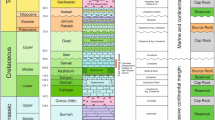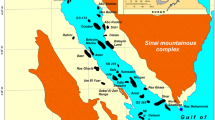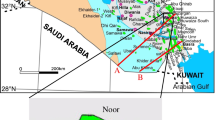Abstract
The Huhehu Sag is one of the most important oil and gas depressions in the Hailar Basin. However, the origin of Huhehu oil is still controversial. Previous studies on source rocks have mainly focused on the Nantun Formation (K1n); a few studies have investigated the Damoguaihe Formation (K1d). Based on the Rock–Eval pyrolysis parameters, 172 drill cutting samples from the Huhehu Sag were analyzed to evaluate their geochemical characteristics. Based on the Rock–Eval data, the mudstones from the first member of the Damoguaihe Formation (K1d1) and the second member of the Nantun Formation (K1n2) have moderate to high hydrocarbon generation potential, while mudstones from the first member of the Nantun Formation (K1n1) have poor to good hydrocarbon generation potential. Additionally, both the K1n1 and K1n2 coal members have poor to fair hydrocarbon generation potential, but the K1n2 coal member has a better generative potential. Fifteen Huhehu oils were collected for molecular geochemical analyses to classify the oils into genetic families and to identify the source rock for each oil using chemometric methods. The Huhehu oils were classified into three groups with different maturity levels using hierarchical cluster analysis and principal component analysis. Group A oils (high maturity) are characterized by relatively moderate ratios of Pr/Ph, Pr/n-C17, and Ph/n-C18, as well as an abundance of C29 steranes, mainly derived from the K1n2 and K1n1 mudstone members. In comparison, group B oils (moderate maturity) have relatively low Pr/Ph ratios, moderate Pr/n-C17 and Ph/n-C18 ratios, and low concentrations of C29 steranes. Group C oils (low maturity) show relatively high ratios of Pr/Ph, Pr/n-C17, and Ph/n-C18, as well as high concentrations of C29 steranes. Furthermore, group B oils derived from the K1d1 mudstone member and group C oils derived from the K1n2 coal member were also identified by principal component analysis score plots. Correlation studies suggest a major contribution from the K1n mudstone Formation and the K1d1 mudstone member to the oils of the Huhehu Sag. So, the Nantun Formation and relatively shallow strata of the Damoguaihe Formation (e.g., the K1d1 member) represent important targets for future oil-reservoir exploration in the Huhehu Sag.















Similar content being viewed by others
References
Amiri V, Nakhaei M, Lak R (2017) Using radon-222 and radium-226 isotopes to deduce the functioning of a coastal aquifer adjacent to a hypersaline lake in NW Iran. J Asian Earth Sci 147:128–147
Brito M, Rodrigues R, Baptista R, Duarte LV, Azerêdo AC, Jones CM (2017) Geochemical characterization of oils and their correlation with Jurassic source rocks from the Lusitanian Basin (Portugal). Mar Pet Geol 85:151–176
Cao RC, Wang WM, Shang JH, Wang QK (2010) Research into hydrocarbon source rocks in Huhehu Depression by application of sequence stratigraphic geochemistry method. J Northeast Pet Univ 34:18–22 (in Chinese with English abstract)
Chakhmakhchev A, Suzuki N, Suzuki M, Takayama K (1996) Biomarker distributions in oils from the Akita and Niigata Basins, Japan. Chem Geol 133:1–14
Chen HP (2014) Geochemical characteristics and oil-source rock correlation of Nantun coal measure source rocks in Huhehu Sag. West-China Exploration Engineering, pp 50–57 (in Chinese)
Chen JP, Zhao CY, He ZH (1997) Criteria for evaluating the hydrocarbon-generating potential of organic matter in coal measures. Pet Explor Dev 24:1–5 (in Chinese with English abstract)
Chen JP, Zhao CY, Wang ZY, He ZH, Qin Y (1998) Organic geochemical characteristics of oil, gas and source rocks of Jurassic coal measures in Northwestern China. Geol Rev 44:149–159 (in Chinese with English abstract)
Chen JP, Wu HY, Zhu DF, Lin CH, Yu DS (2007) Tectonic evolution of the Hailar Basin and its potentials of oil-gas exploration. Chin J Geol 42:147–159 (in Chinese with English abstract)
Chen XH, Lu SF, Xue HT, Li JH, Liu QH, Hu SM, Huang WB (2011) Seismic facies of the Cretaceous in the Huhehu Depression, Hailar Basin. Pet Explor Dev 38:321–327 (in Chinese with English abstract)
Cui JP, Ren ZL, Su Y, Zhang S, Liu L (2007) Relationship between present geo-temperature and hydrocarbon generation in Hailar Basin. Pet Explor Dev 34:445–450 (in Chinese with English abstract)
Didyk BM, Simoneit BRT, Brassell SC, Eglinton G (1978) Organic geochemical indicators of palaeoenvironmental conditions of sedimentation. Nature 272:216–222
Ding H, Liu CQ, Zhao ZQ, Li SL, Lang YC, Li XD, Hu J, Liu BJ (2017) Geochemistry of the dissolved loads of the Liao River basin in northeast China under anthropogenic pressure: chemical weathering and controlling factors. J Asian Earth Sci 138:657–671
Dong L, Wang WM, Yu XB, Wang GH (2011) Study on hydrocarbon accumulation stages in Nantun Formation, Huhehu Depression, Hailar Basin. Pet Geol Recovery Effic 18:20–23 (in Chinese with English abstract)
Fu JM, Sheng GY, Peng PA, Brassell SC, Eglinton G, Jiang J (1986) Peculiarities of salt lake-sediments as potential source rocks in China. Org Geochem 10:119–126
Hao F, Zhou XH, Zhu YM, Bao XH, Yang YY (2009) Charging of the Neogene Penglai 19-3 field, Bohai Bay Basin, China: oil accumulation in a young trap in an active fault zone. Am Assoc Pet Geol Bull 93:155–179
Hao F, Zhou XH, Zhu YM, Zou HY, Yang YY (2010) Charging of oil fields surrounding the Shaleitian uplift from multiple source rock intervals and generative kitchens, Bohai Bay basin, China. Mar Pet Geol 27:1910–1926
Hao F, Zhang ZH, Zou HY, Zhang YC, Yang YY (2011) Origin and mechanism of the formation of the low-oil-saturation Moxizhuang field, Junggar Basin, China: implication for petroleum exploration in basins having complex histories. Am Assoc Pet Geol Bull 95:983–1008
He M, Moldowan JM, Nemchenko-Rovenskaya A, Peters KE (2012) Oil families and their inferred source rocks in the Barents Sea and northern Timan-Pechora Basin, Russia. Am Assoc Pet Geol Bull 96:1121–1146
Huang WY, Meinschein WG (1979) Sterols as ecological indicators. Geochim Cosmochim Acta 43:739–745
Huang DF, Xiong CW (1996) Generation, migration and evaluation of hydrocarbon generation potential of oil formed in coal-bearing strata. China Pet Exp 1:6–11 (in Chinese with English abstract)
Hunt JM (1996) Petroleum geochemistry and geology. W.H. Freeman, New York
Jiang ZL, Qiu HJ, Huang YP, Fu WK, Jiang KP, Chen J (2014) Jurassic lacustrine source rock characteristics and its petroleum geological significance in the Southeast Depression of Tarim Basin, China. Arab J Geosci 7:5093–5106
Li S, Mao XP, Tang DZ, Tao S, Yang WH (2009) Resource assessment of coal-derived in Huhehu Depression, Hailar Basin. Geol China 36:1350–1358 (in Chinese with English abstract)
Li JH, Lu SF, Meng QA, Liu QH, Chen XH, Hu SM (2010) Typical sand characteristic of Nantun Formation in the Huhehu Depression in the Hailar Basin. Acta Geol Sin 84:1495–1501 (in Chinese with English abstract)
Liu HY (2010) The evaluation of hydrocarbon source rock in Huhehu Depression. Dissertation, Daqing Petroleum Institute
Liu QH, Lu SF, Li JH, Chen XH, Hu SM (2010) Sequence stratigraphic and sedimentary system analysis of Nantun group in Huhehu Depression in Hailar Basin. Acta Geol Sin 28:227–234 (in Chinese with English abstract)
Lu K, Hou DJ, Hong HF, Cao HM (2010) Geochemical characteristics of crude oil and correlation of source rock in Huhehu Sag. J Guilin Univ Technol 30:28–32 (in Chinese with English abstract)
Mashhadi ZS, Rabbani AR, Kamali MR (2015) Geochemical characteristics and hydrocarbon generation modeling of the Kazhdumi (Early Cretaceous), Gurpi (Late Cretaceous) and Pabdeh (Paleogene) formations, Iranian sector of the Persian Gulf. Mar Pet Geol 66:978–997
Meng YL, Xu C, Xiao LH, Zhou XG, Hu AW (2014) Organic geochemistry of Lower Jurassic source rocks in Xining Basin. Nat Gas Geosci 25:588–594 (in Chinese with English abstract)
Peters KE (1986) Guidelines for evaluating petroleum source rock using programmed prolysis. Am Assoc Pet Geol Bull 70:318–329
Peters KE, Moldowan JM (1991) Effects of source, thermal maturity, and biodegradation on the distribution and isomerization of homohopanes in petroleum. Org Geochem 17:47–61
Peters KE, Walters CC, Moldowan JM (2005) The biomarker guide: biomarkers and isotopes in petroleum and earth history, 2nd edn. Cambridge University Press, Cambridge
Peters KE, Scott RL, Zumberge JE, Valin ZC, Scotese CR, Gautier DL (2007) Circum-Arctic petroleum systems identified using decision-tree chemometrics. Am Assoc Pet Geol Bull 91:877–913
Peters KE, Hostettler FD, Lorenson TD, Rosenbauer RJ (2008) Families of Miocene Monterey crude oil, seep, and tarball samples, coastal California. Am Assoc Pet Geol Bull 92:1131–1152
Peters KE, Coutrot D, Nouvelle X, Ramos LS, Rohrback BG, Magoon LB, Zumberge JE (2013) Chemometric differentiation of crude oil families in the San Joaquin Basin, California. Am Assoc Pet Geol Bull 97:103–143
Peters KE, Wright TL, Ramos LS, Zumberge JE, Magoon LB (2016) Chemometric recognition of genetically distinct oil families in the Los Angeles basin, California. Am Assoc Pet Geol Bull 100:115–135
Qu GN (2005) Study on the best object appreciation of coal-bed methane in the Huhehu Depression of Hailar Basin. Dissertation, Liaoning Technical University
Seifert WK, Moldowan JM (1978) Applications of steranes, terpanes and monoaromatics to the maturation, migration and source of crude oils. Geochim Cosmochim Acta 42:77–95
Seifert WK, Moldowan JM (1980) The effect of thermal stress on source-rock quality as measured by hopane stereochemistry. Phys Chem Earth 12:229–237
Seifert WK, Moldowan JM (1986) Use of biological markers in petroleum exploration. Methods Geochem Geophys 24:261–290
Sinninghe Damsté JS, Kenig F, Koopmans MP, Köster J, Schouten S, Hayes JM, de Leeuw JW (1995) Evidence for gammacerane as an indicator of water column stratification. Geochim Cosmochim Acta 59:1895–1900
Song HX, Wen ZG, Bao JP (2015) Geochemical characteristics and hydrocarbon potential of the coal in Muli area of Qilian Mountain. Nat Gas Geosci 26:1803–1813 (in Chinese with English abstract)
Telnæs N, Cooper BS (1991) Oil-source rock correlation using biological markers, Norwegian continental shelf. Mar Pet Geol 8:302–310
Tissot BP, Welte DH (1984) Petroleum formation and occurrence, 2nd edn. Springer, Berlin
Tissot BP, Pelet R, Ungerer P (1987) Thermal history of sedimentary basins, maturation indices and kinetics of oil and gas generation. Am Assoc Pet Geol Bull 71:1445–1466
Wang CJ (1998) A “folded-fan” method for assessment on the hydrocarbon-generating potential of coals. Geochimica 27:483–492 (in Chinese with English abstract)
Wang PJ, Zhong JH, Niu YB (2009) Tectonic feature and evolution of Huhehu Depression in Hailar Basin. Spec Oil Gas Reserv 16:25–27 (in Chinese with English abstract)
Wang YP, Zhang F, Zou YR, Zhan ZW, Peng PA (2016) Chemometrics reveals oil sources in the Fangzheng Fault Depression, NE China. Org Geochem 102:1–13
Wang YP, Zhang F, Zou YR, Lin XH, Liang T (2018) Oil source and charge in the Wuerxun Depression, Hailar Basin, northeast China: a chemometric study. Mar Pet Geol 89:665–686
Wu HB, Li JH (2012) Sequence stratigraphic geochemistry and its application to the evaluation of source rocks of Huhehu Sag in Hailar Basin. Acta Geol Sin 86:661–670 (in Chinese with English abstract)
Yang ZR, Zhang YF, Yao Y (2008) Potential analysis coalbed gas resources in Huhehu Depression, Hailar Basin. Coal Geol Explor 36:15–18 (in Chinese with English abstract)
Zhang F (2014) Geochemical characteristic and hydrocarbon-generating potential of coal-bearing source rock with middle to low rank, Huhehu Depression. Nat Gas Explor Dev 37:19–24 (in Chinese with English abstract)
Zhang MF, Xiong DL, Wu CJ, Ma WY, Sun LN, Tuo JC (2016) Source rock condition and the formation of Jurassic low-maturity gases in the eastern Junggar Basin. Nat Gas Geosci 27:261–267 (in Chinese with English abstract)
Zumberge JE, Russell JA, Reid SA (2005) Charging of Elk Hills reservoirs as determined by oil geochemistry. Am Assoc Pet Geol Bull 89:1347–1371
Acknowledgements
This study was funded by the Natural Science Funding Council of China (Grant Nos. 41273059), GIGCAS 135 project (Grant No. Y234021001) and Earmarked Fund of the State Key Laboratory of Organic Geochemistry (Grant No. sklog2016-A01). The authors are deeply indebted to two anonymous reviewers who provided constructive reviews in our original manuscript. We also wish to acknowledge managing editor Wang Binbin for the timely handling with the manuscript.
Author information
Authors and Affiliations
Corresponding author
Ethics declarations
Conflict of interest
The authors declare that they have no conflict of interest.
Rights and permissions
About this article
Cite this article
Wang, YP., Zhang, F., Zou, YR. et al. Origin and genetic family of Huhehu oil in the Hailar Basin, northeast China. Acta Geochim 37, 820–841 (2018). https://doi.org/10.1007/s11631-018-0288-1
Received:
Revised:
Accepted:
Published:
Issue Date:
DOI: https://doi.org/10.1007/s11631-018-0288-1




